AMD’s 5 GHz Turbo CPU in Retail: The FX-9590 and ASRock 990FX Extreme9 Review
by Ian Cutress on August 9, 2014 8:00 AM ESTCPU Benchmarks: Comparing the AMD FX-9590
The dynamics of CPU Turbo modes, both Intel and AMD, can cause concern during environments with a variable threaded workload. There is also an added issue of the motherboard remaining consistent, depending on how the motherboard manufacturer wants to add in their own boosting technologies over the ones that Intel would prefer they used. In order to remain consistent, we implement an OS-level unique high performance mode on all the CPUs we test which should override any motherboard manufacturer performance mode.
It is worth noting that the FX-9590, against the A10-7850K for example, has double the threads and +1 GHz of core speed, despite the generational gap. Considering only these factors, the FX-9590 is most likely similar if not better at single threaded performance, but also 2x for multithreaded results.
HandBrake v0.9.9: link
For HandBrake, we take two videos (a 2h20 640x266 DVD rip and a 10min double UHD 3840x4320 animation short) and convert them to x264 format in an MP4 container. Results are given in terms of the frames per second processed, and HandBrake uses as many threads as possible.
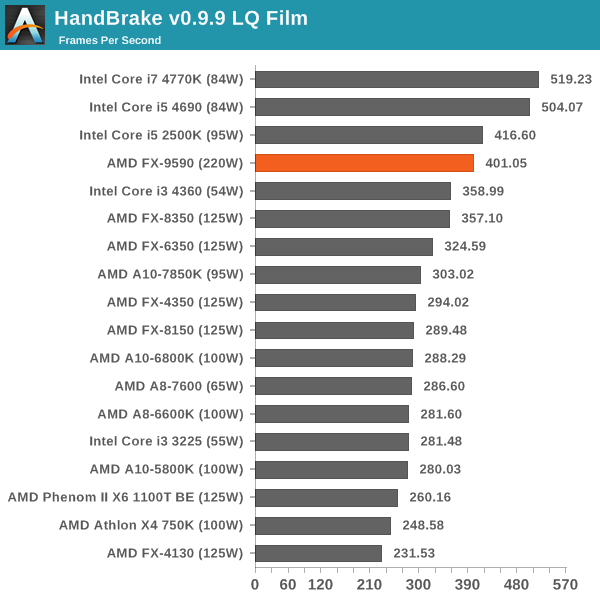
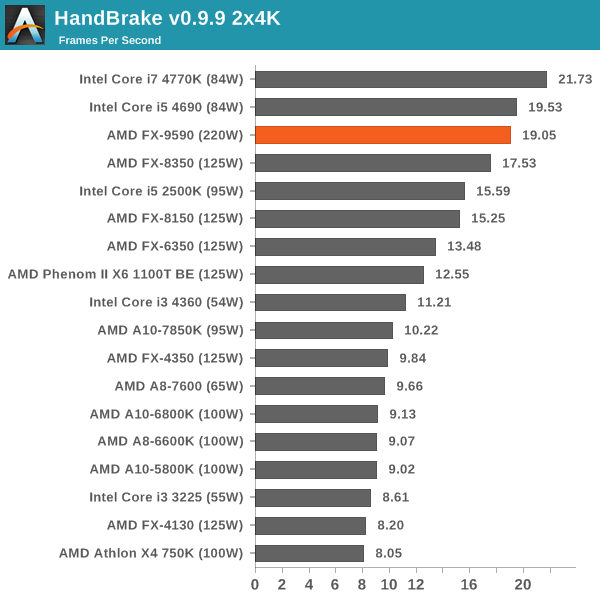
The eight threads of the FX-9590 give it almost another third of performance over the A10-7850K for small frame videos and nearly 2x for the larger frame conversion.
Agisoft Photoscan – 2D to 3D Image Manipulation: link
Agisoft Photoscan creates 3D models from 2D images, a process which is very computationally expensive. The algorithm is split into four distinct phases, and different phases of the model reconstruction require either fast memory, fast IPC, more cores, or even OpenCL compute devices to hand. Agisoft supplied us with a special version of the software to script the process, where we take 50 images of a stately home and convert it into a medium quality model. This benchmark typically takes around 15-20 minutes on a high end PC on the CPU alone, with GPUs reducing the time.
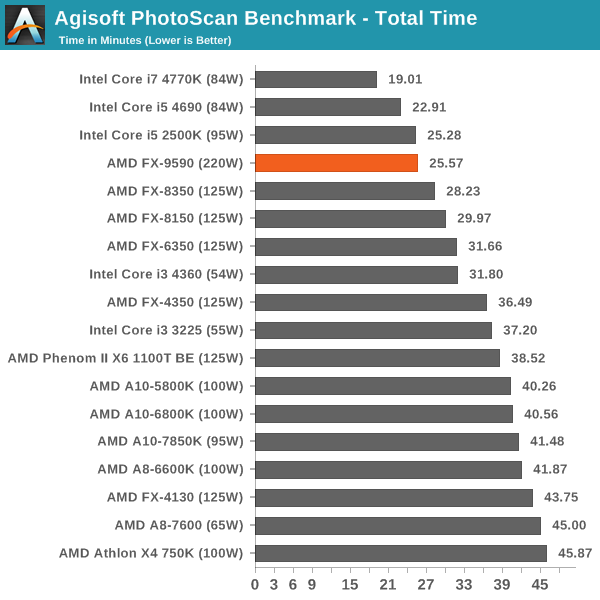
The FX-9590 puts in the best AMD CPU performance, similar to that of the i5-2500K.
Dolphin Benchmark: link
Many emulators are often bound by single thread CPU performance, and general reports tended to suggest that Haswell provided a significant boost to emulator performance. This benchmark runs a Wii program that raytraces a complex 3D scene inside the Dolphin Wii emulator. Performance on this benchmark is a good proxy of the speed of Dolphin CPU emulation, which is an intensive single core task using most aspects of a CPU. Results are given in minutes, where the Wii itself scores 17.53 minutes.
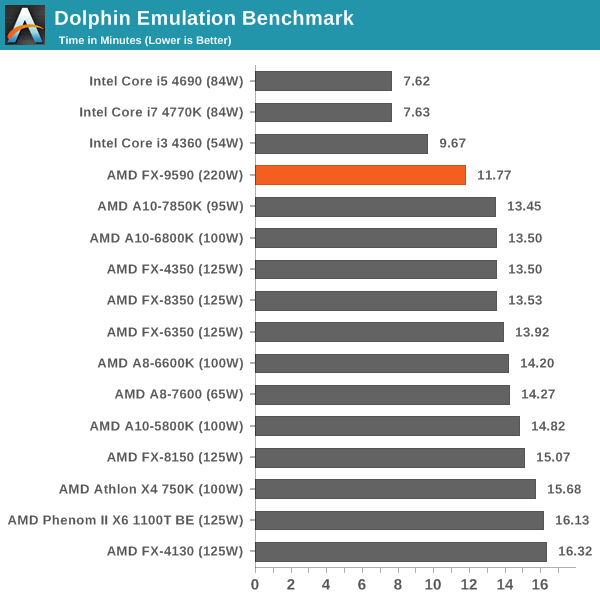
The FX-9590 beats almost everything pre-Haswell, showing the strength of a 5.0 GHz turbo mode. Note that it compares to the 3.5 GHz, 4MB L3 cache Haswell, which is 1.5 GHz slower and has half the L3.
WinRAR 5.0.1: link
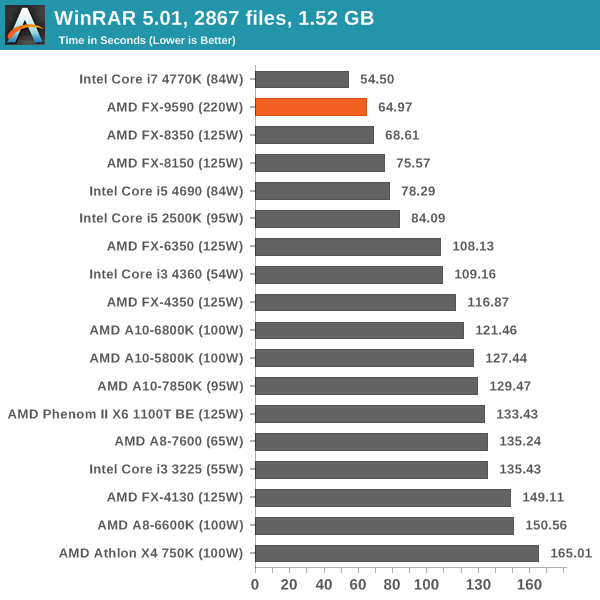
PCMark8 v2 OpenCL on R7 240
A new addition to our CPU testing suite is PCMark8 v2, where we test the Work 2.0 and Creative 3.0 suites in OpenCL mode.
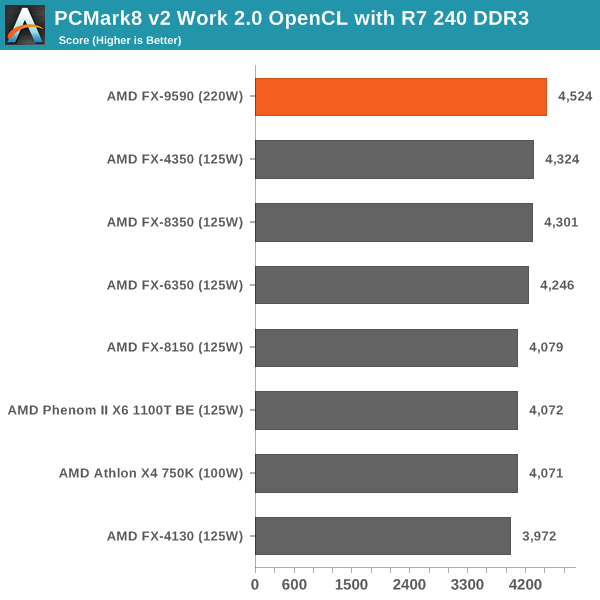
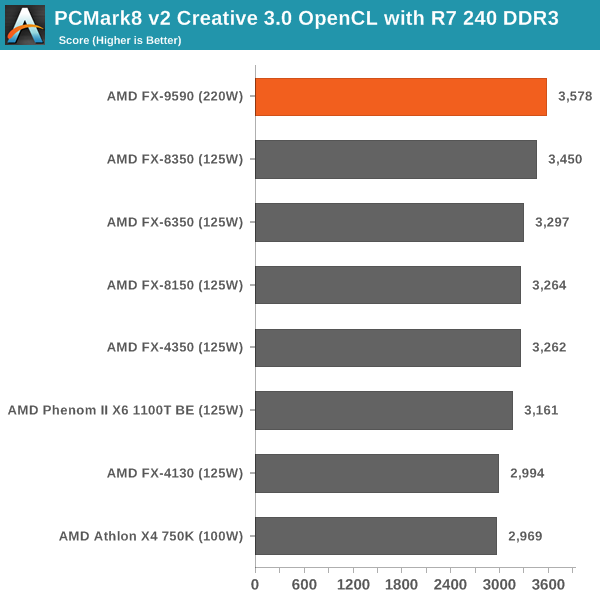
Hybrid x265
Hybrid is a new benchmark, where we take a 4K 1500 frame video and convert it into an x265 format without audio. Results are given in frames per second.
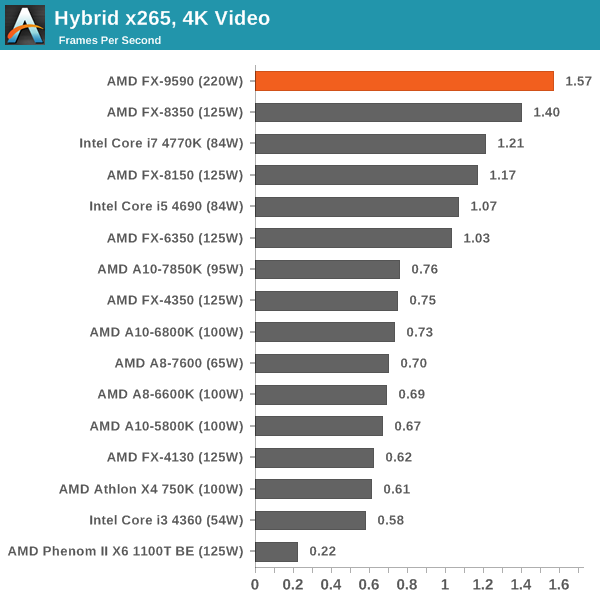
The FX-9590 holds up very well in the Hybrid x265 conversion, which makes me wonder how well an 8-thread Kaveri CPU would perform.
Cinebench R15
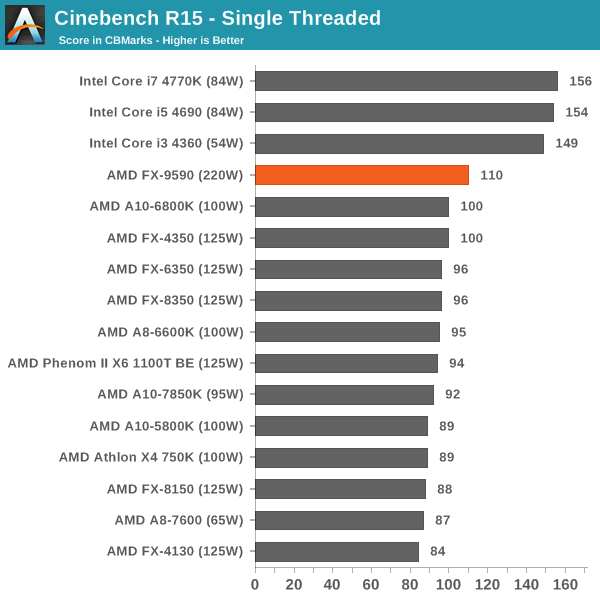
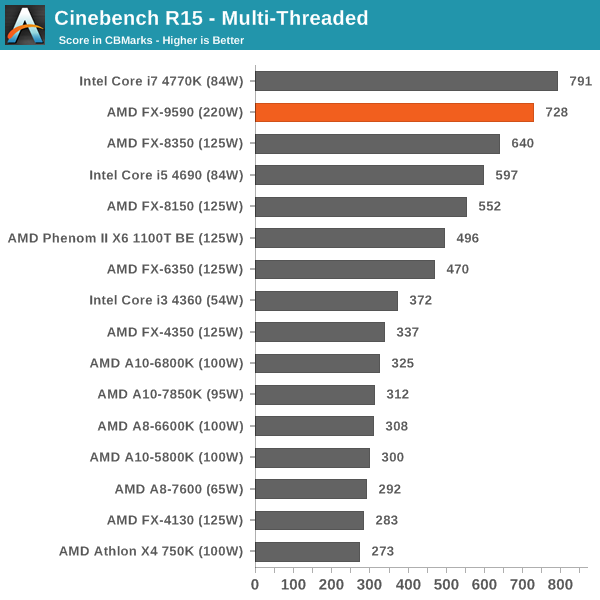
The FX-9590 still has the single thread edge over the newer AMD CPUs due to the high frequency, but is easily overtaken by the modern cheap Intel CPUs. For multithreaded competition, the 8 threads needs an 8 threaded Intel CPU to compete.
3D Particle Movement
3DPM is a self-penned benchmark, taking basic 3D movement algorithms used in Brownian Motion simulations and testing them for speed. High floating point performance, MHz and IPC wins in the single thread version, whereas the multithread version has to handle the threads and loves more cores.
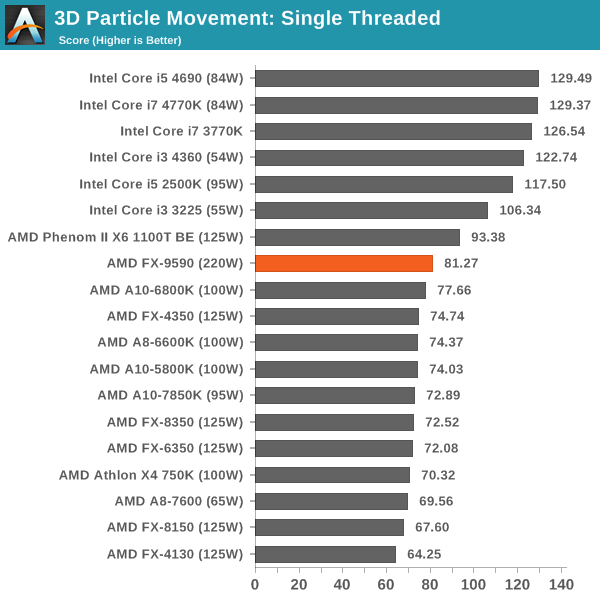
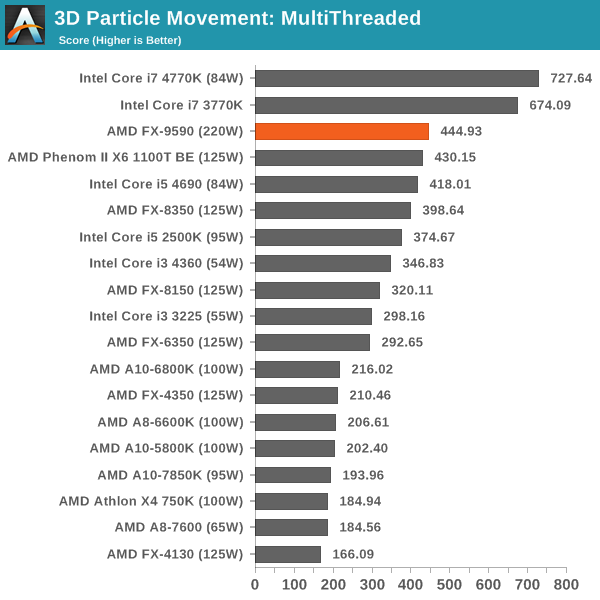
Although the FX-9590 again performs as the best AMD CPU, the floating point nature of the calculations in this test seems not to be favored by this architecture.
FastStone Image Viewer 4.9
FastStone is the program I use to perform quick or bulk actions on images, such as resizing, adjusting for color and cropping. In our test we take a series of 170 images in various sizes and formats and convert them all into 640x480 .gif files, maintaining the aspect ratio. FastStone does not use multithreading for this test, and results are given in seconds.

Similarly to 3DPM, for basic photo conversion any base 3.2 GHz Haswell CPU can outperform a 5.0 GHz AMD.










146 Comments
View All Comments
TiGr1982 - Saturday, August 9, 2014 - link
No, no FX in the future - at least, not on Bulldozer-derived microarchitectures.Just APUs till 2016 at least.
will1956 - Saturday, August 9, 2014 - link
i've gotten the sabertooth 990FX GEN3 R2.0 and its got pcie 3 x16 with a 8350 and a sapphire 7870 ghz (both OC'ed) and its pretty good although rather greedyTiGr1982 - Saturday, August 9, 2014 - link
It's nice that this kind of boards exist, but, sadly, PCI Express 3.0 is a rarity rather than a norm on AM3+.AMD only has PCI Express 3.0 as a standard on FM2+ with Kaveri APU.
roadapathy - Saturday, August 9, 2014 - link
I see by the comments below that I'm among the rational. AMD is stuck on the 32nm fab process making for a dismal performance experience for us all! My AMD 6-core could boil water. This is great for the cold midwestern American climate but the Summer is unbearable with AMD CPUs. I had waited over 2 years for a 22nm AMD 8 core FX that never appeared. Meanwhile, I'm running the "lower" 95watt CPU. I can't even imagine how it would be with the 220watt. How ridiculous!!RussianSensation - Sunday, August 10, 2014 - link
Exactly!! Someone understands. If AMD could move to 14nm, they could increase the number of modules 50%-100% and lower the power usage at the same time. When you CPU is on 32nm while Intel is soon to launch 14nm Broadwell, the chance of AMD competing in performance or performance/watt is 0%.Death666Angel - Sunday, August 10, 2014 - link
But more cores aren't really the issue for AMD, are they? In multi-threaded stuff they are already doing fine. What they need is better IPC. Even at 5GHz they barely beat i3s of the current generation. Unfortunately the FX-9590 isn't in bench yet, but the FX-8350 even loses to a chip on 32nm (i5-2500k) in most benchmarks except some multi threaded ones. Put an i7-2600k in its place and it loses even more consistently. That is not just a lithography disadvantage, that is a straight up embarrassment from the CPU architecture standpoint. And the fact that they aren't releasing any more FX CPUs based on newer architectures is a slap in the face of any PC enthusiast.TiGr1982 - Monday, August 11, 2014 - link
Indeed; placed my response too.Budburnicus - Wednesday, January 14, 2015 - link
exactly! AMD has HORRIBLE IPC which results in horrible efficiency - ALSO bear in mind that the 3 year old i5 and i7 parts are 32nm fab, and are 95 watt TDP parts - which can easily be clocked at 4.7 Ghz and totally SPANK this CPU in every way!AMD need a totally new architecture to go with a new fabrication, otherwise it will remain meaningless and eat more power. IPC is incredibly important - just because this FX 9590 is much newer than an i7-2600K and therefore has more and newer instruction sets, does NOT mean it performs better! It performs far worse in fact - whilst eating more power - using the same fab size!
TiGr1982 - Monday, August 11, 2014 - link
It's not the manufacturing tech itself - their Bulldozer-derived microarchitecture has drastically slower IPC (Instructions Per Clock). If you you emphasize lithography, then let's compare FX Piledriver from late 2012 on GF 32 nm lithography and Sandy Bridge LGA1155 Core i7 from early 2011 on Intel's 32 nm lithography.Guess what? Sandy Bridge is around 50% faster in single threaded tasks than Pilderiver. At the "same" lithography. Despite the fact that Sandy Bridge i7 has just 9 MB L2+L3 cache, while Piledriver has 16 MB L2+L3 cache. So, AMD's chip has almost twice the amount of cache than Intel's chip and is still 50% slower. So, first, the case with AMD FX is mainly a problem of inappropriate microarchitecture, and only then comes the lithography lag.
So, even if a Cinderella's fairy comes up and magically moves FX Piledriver to Intel's 22 nm or even 14 nm, the resulting tiny Piledriver shrink will still be a Slowpoke in single thread duties - because it is its microarchitecture that prevents it from doing better.
roadapathy - Monday, August 11, 2014 - link
I don't have a complaint about the architecture itself because of the price points. Intel CPU, motherboard and the RAM are all much more expensive! I'd be satisfied with AMD FX series (or the new Kavari) on the 20nm fab process.